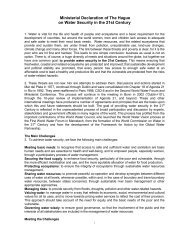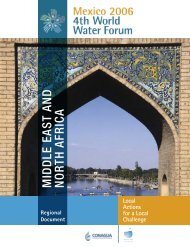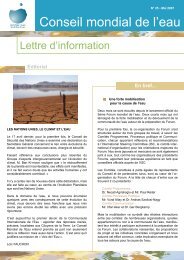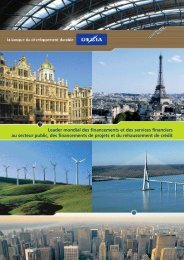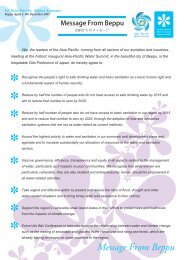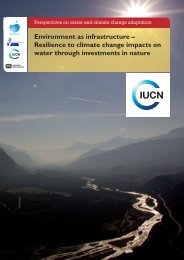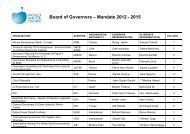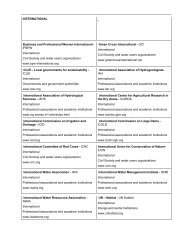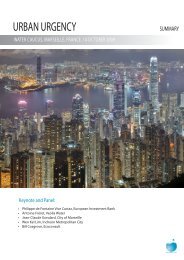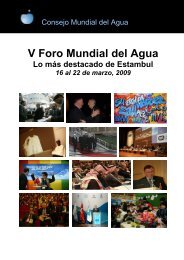684th <strong>World</strong> <strong>Water</strong> Forumadvances have been made regarding local participationfor an efficient risk management, but the regioncontinues to be devastated by natural hazards. Somecountries in Latin America and the Caribbean madean unsuccessful effort to negotiate the elimination ofagricultural subsidies in First <strong>World</strong> countries. Althoughthis point of contention between countries in the Northand countries in the South still remains, its solution wasgreatly advanced in the Hong Kong meeting of the WTO.Issues relating to water management do not varysignificantly throughout the region, although prioritiestypically differ, particularly between North America andthe countries of Latin America and the Caribbean. TheBox 7.2 Day of the <strong>Americas</strong>, 3rd <strong>World</strong><strong>Water</strong> ForumKyoto, Japan, March 2003LESSONS LEARNED“A balanced set of policies and institutional reformsharnessing the efficiency of market forces andstrengthening government capacities has beeninitiated in LAC. The region has outstanding, althoughcontroversial, examples of market-based approachesto water management and water services privatization.It is also a showcase for bottom-up decision-makingriver basin organizations, decentralization andmunicipalization processes, and conceptualization ofparticipatory water planning processes.Sub regions like Central America have developedstrong regional institutional frameworks. Strongenvironmental movements have also appeared in LAC.Mechanisms for political dialogue within and betweencountries sharing transboundary river basins andmarine resources exist in North, Central and SouthAmerica and the Caribbean region.Beneficial impacts such as increased efficiency inwater use, increased civil society participation anduse of conflict resolution mechanisms have occurredover time. Despite important gains, however, thereis much to be accomplished in LAC. Problems stillpersist and the region has learned valuable lessons:water resources management and institutionalsettings cannot be independent from external andnational overall political, economic and administrativeorganizational structures at a given moment in time.”SOURCE: 3rd <strong>World</strong> <strong>Water</strong> Forum, Day of the <strong>Americas</strong> Declaration, 2003.goals of Canada’s Federal <strong>Water</strong> Policy are related tothe protection and enhancement of the quality of thewater resource and to promote the wise and efficientmanagement and use of water. In the USA, a <strong>Water</strong>Infrastructure Financing Act was introduced to theSenate in July 2005, with provisions to finance morethan US$ 20 billion over five years for a variety of loans,grants, and studies. Most of the money would be directedto the Clean <strong>Water</strong> State Revolving Fund, the stateadministered programs that provide low interest loans towastewater and water utilities (Civil Engineering 2005).Arecent <strong>Water</strong> Policy Dialogue sponsored by the American<strong>Water</strong> Resources Association (AWRA) identified four keywater challenges and two crosscutting issues. The fourchallenges were: promoting more integrated approaches,reconciling the current Ad-Hoc National <strong>Water</strong> Policy,Developing collaborative partnerships, and providinginformation for sound decision making. Crosscuttingissues included: financing water improvements andeducating the public and public officials about waterchallenges (AWRA 2005). Conclusions from the fifthIbero-American Forum of Environment Ministers heldin Colon, Panama in September 2005 included 14 itemsrelated to water. These underline four prerequisites forIWRM: a strategy for IWRM including groundwater, anadequate environmental valuation of water, the existenceof adequate basic infrastructure for water supply andsanitation, and the existence of an adequate policy andinstitutional framework.1. <strong>Water</strong> for Growth and Development<strong>Water</strong> as an end and water as a means. Growth anddevelopment objectives continue to dominate nationalagendas with economic growth and poverty alleviation ofprimary importance among Latin American and Caribbeannations. While advances have been made towardunderstanding the relationships between water and itsrole in the economy, society and environment not allcountries within the region have clearly defined the role ofwater in achieving national goals. The effects of increasingglobalization and trade liberalization on national waterresources are only beginning to be realized, with thesubject of water and trade a recurring theme in waterfora in Latin America and the Caribbean, and continue toraise concerns in several countries. <strong>Water</strong> managementparadigms continue to be vigorously debated across theregion and there many hurdles to be had before it can besaid that any one dominates in the region.
The intuitive relationship between water managementand socioeconomic development is often confoundedby a lack of suitable indicators. The absence of suchindicators complicates the identification of cause andeffect that would enable the role of water in growthand development to be isolated from other economic,social, and environmental effects. Although emphasis hasshifted toward demand management, rather than supplyaugmentation, a debate on how to reach an equitableand sustainable balance between the two persists. Whilegovernments have traditionally established priorities withrespect to water, this is changing with the introductionof market-based approaches. Introduced to improveincremental benefits for the scarce available resourcesgrowth and poverty alleviation such objectives have notalways been clearly demonstrated and despite nobleintentions society often pursues alternate objectives.Competing demands among various sectors of society andthe economy continue to stimulate debate on the mostappropriate mechanisms to manage water.Brazil (2005) has proposed a common water resourcesmanagement strategy for the Latin American andCaribbean countries, towards the adoption of commonmeasures for poverty alleviation and for reducing therestrictions to development imposed by an inadequateaccess to water in the hemisphere. The core of thestrategy rests on common long-term actions for solvingthe major water management problems in national andtransboundary waters. The convergence of nationalwater policies for the sustainable use of water as well asSouth-South cooperation processes for the creation ofa Common <strong>Water</strong> Resources Development Fund, amongothers, are posed as specific objectives of the strategy.As a result of meetings held by Organizations of theCivil Society during the preparatory process for the 4th<strong>World</strong> <strong>Water</strong> Forum, the six basic statements listed in Box7.3 were put forward.While the region has accepted the premise ofsustainable development it continues to debate theemphasis that should be afforded to economic, social,and environmental goals within the national context.Proposals for the maximization of economic growthsubject to social and environmental restrictions havebeen met with counterproposals to maximize equity orenvironment, subject to restrictions imposed by the othertwo vertices of the sustainable development triangle.Previously irreconcilable struggles between those thatregard water as an economic good and those regardingwater as a human right are beginning to give way toproposals 51 aiming to show both views are compatible andmutually beneficial. The remaining challenge is to developappropriate mechanisms for maximizing the contributionof water to clearly define and strategically pursue social orenvironmental objectives at national and regional levels.51Such as one presented by FAN-CA.694th <strong>World</strong> <strong>Water</strong> ForumBox 7.3 Statements of Civil Society Organizations during the preparatory meetings• That water be a fundamental human right and natural and cultural patrimony of nations, guarantee its accessin quality, quantity, and continuity to all persons and societies, especially to poor communities and to the mostvulnerable sectors;• That water be a priority within public policies;• That civil society participates in a binding manner in decision making through adequate means and at adequatelevels in the planning, management, and regulation of water and its services;• That management, use, and distribution of water be made according to rules of justice, equity, andsustainability;• That rural communities have secure water supply sources with legal provisions to guarantee all uses made bysuch communities;• That the water-related function of forests, prairies, moors, wetlands and all natural vegetation land cover beconserved; and that an integrated management and conservation of watersheds, including transboundary riverbasins, be developed.SOURCE: CN/RCA (2005)



